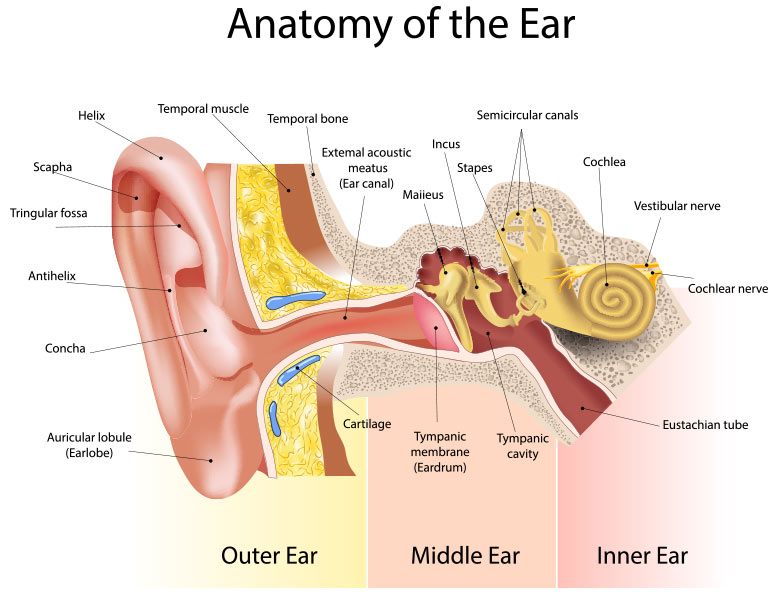After 40 plus years of being completely deaf in one ear, I heard. This isn’t some sort of enlightened metaphor, I really heard from both sides of my head. If you have difficulty hearing, suffer from tinnitus, fight with hearing aids, or are worried about impacting your ear drums using ear buds, then you’ll want to read on about my experience with this new technology.
Through an operation gone wrong when I was a child, I was left deaf in one ear. It’s been so long that I don’t even remember hearing with both, and a hearing aid wouldn’t help my situation because the ear drum was all but gone. To make matters worse, I recently developed slight tinnitus and having that investigated through a hearing clinic brought me to the discovery of bone conduction.
WHAT IS BONE CONDUCTION
The way that our hearing works under normal conditions is that sound travels through the opening in our ear (outer ear) into the hearing canal and finds its way to the ear drum. The ear drum then converts whatever sounds it received into vibrations. From there a series of events continue through the middle and inner ear, specifically the cochlea, which is connected to the auditory nerve sending messages to the brain.

Bone conduction takes a different path, a detour if you will. The sound is received by the bones in your skull or face and transmitted through vibration directly to the inner ear (cochlea), avoiding the outer and middle ear.
The use of bone conduction devices shouldn’t be confused with a cochlear implant, which may have some similarities, but serves a different function when it comes to how it interacts with the parts of the ear.
BONE CONDUCTION TECHNOLOGY
While you can have surgery to achieve bone conduction hearing benefits that are more complete, there are also some less invasive devices you can use for day-to-day functions as perhaps a first step.
The device I’ve tried along with friends and family is the AfterShokz OpenMove Wireless Bone Conduction Open-Ear Bluetooth Waterproof Sports Headphones. These headphones connect through Bluetooth to a Smart Phone, a Smart TV, or any other output device that has Bluetooth capability, including your computer.
What’s In The Box
The package I purchased came with the headphones, a soft carry pouch, a USB-C charging cable, and earplugs. I’ll explain more about each item and the whole system so you can get a better sense of my personal experience.

A CLOSER LOOK AT WHAT YOU GET
The headphones are lightweight, flexible, and soft. They’re also rigid enough that they rest on your head without falling. They have a volume up/down button on the left arm, along with a covered charging port. There is a touch enabled button integrated into the right arm that helps you answer calls or play a song with one touch, skip songs with two, and go backwards with three.
Connecting the headphones to my phone and tv took less than five minutes through the normal Bluetooth connection procedures. I have also typically used the device for about 6-8 hours before I needed to recharge the battery and that has remained consistent over the last few months.
The carry bag is a nice addition that keeps the headphones dust free and adds convenience to portability. There is an easy draw string at the top that helps ensure the headphones stay secured.
The USB-C charging cable plugs into any standard USB charging port or you can add a wall unit to it as well.
The earplugs inclusion confused me at first as I couldn’t figure out why I would need them. Then I learned that if you can hear from your ears under normal condition, the earplugs help block out additional noise so that you can focus on what you hear through bone conduction.
RECOMMENDATION
If you’re unsure about bone conduction as a more permanent solution, this device is a great way to acquaint yourself to the technology. There is an instant return on investment regardless your medical condition, if any. Keep in mind that this device allows you to use bone conduction by connecting to a source (phone, tv, computer, etc…). To achieve full bone conduction hearing, you would need to investigate surgery for a more permanent option.
If you can already hear from both ears, you can still benefit from them and help avoid some of the concerns ear buds pose to hearing impairment as well as canal obstructions.
The headphones do take some getting used to, especially if you can hear out of both or even one ear and may take a few uses for your brain to adjust to information potentially coming through multiple paths. Like orthotics, introducing them a little bit at a time has proven to be the most effective way to make it an even more positive experience. I didn't use the earplugs. It’s important to remember that we all adjust at different levels and pace, so finding your own comfort and approach is important.
FINAL THOUGHTS
There are only good things I can say about this product and the positive impact it has had. I have been able to hear my elderly parents for the first time in decades, my children’s voices, and notes to some of my favourite songs that I never heard before with both ears by connecting to them through my phone.
I can truly say that I have heard like I have never heard before and I hope you can have a similar experience.
This is an opinion article by Guido Piraino of The Monthly Social Podcast. It may also be heard on The Path Radio Mix Online. You can read other opinion articles on the blog page.
For sports content, please consider The Coach's Call YouTube Podcast.
